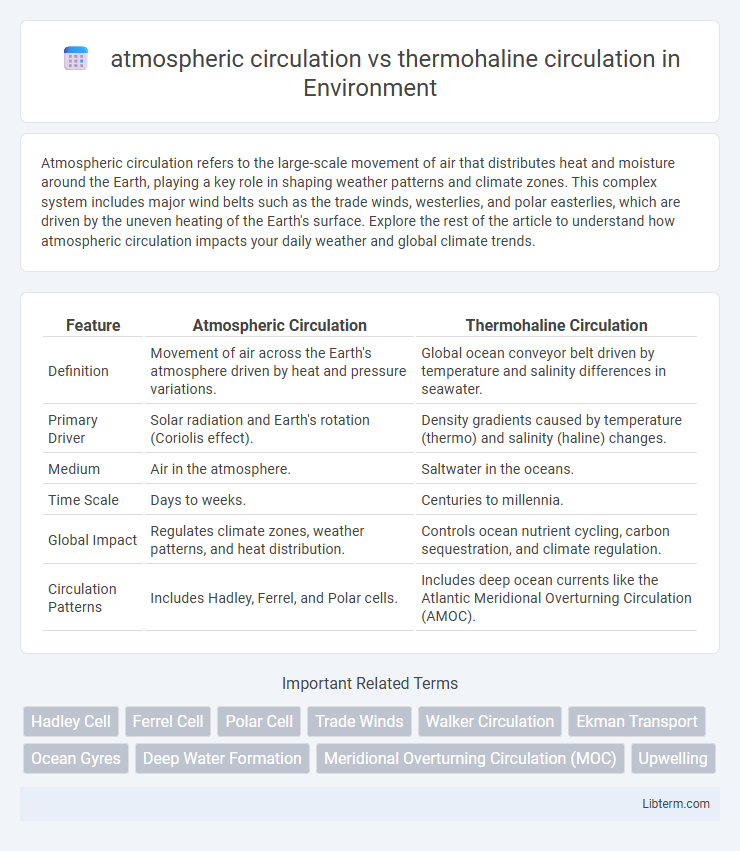Atmospheric circulation refers to the large-scale movement of air that distributes heat and moisture around the Earth, playing a key role in shaping weather patterns and climate zones. This complex system includes major wind belts such as the trade winds, westerlies, and polar easterlies, which are driven by the uneven heating of the Earth's surface. Explore the rest of the article to understand how atmospheric circulation impacts your daily weather and global climate trends.
Table of Comparison
| Feature | Atmospheric Circulation | Thermohaline Circulation |
|---|---|---|
| Definition | Movement of air across the Earth's atmosphere driven by heat and pressure variations. | Global ocean conveyor belt driven by temperature and salinity differences in seawater. |
| Primary Driver | Solar radiation and Earth's rotation (Coriolis effect). | Density gradients caused by temperature (thermo) and salinity (haline) changes. |
| Medium | Air in the atmosphere. | Saltwater in the oceans. |
| Time Scale | Days to weeks. | Centuries to millennia. |
| Global Impact | Regulates climate zones, weather patterns, and heat distribution. | Controls ocean nutrient cycling, carbon sequestration, and climate regulation. |
| Circulation Patterns | Includes Hadley, Ferrel, and Polar cells. | Includes deep ocean currents like the Atlantic Meridional Overturning Circulation (AMOC). |
Introduction to Earth's Circulation Systems
Earth's atmospheric circulation system redistributes heat through large-scale wind patterns driven by solar energy and the planet's rotation, affecting weather and climate globally. Thermohaline circulation, also known as the "global conveyor belt," moves ocean waters driven by variations in temperature and salinity, regulating climate by transporting heat and nutrients between ocean basins. Together, these systems create a dynamic interaction between the atmosphere and oceans, crucial for maintaining Earth's climate balance and supporting ecological systems.
Defining Atmospheric Circulation
Atmospheric circulation refers to the large-scale movement of air that distributes thermal energy across the Earth, driven primarily by solar radiation and the planet's rotation. It encompasses the Hadley, Ferrel, and Polar cells, creating prevailing wind patterns such as trade winds and westerlies that regulate climate zones. Unlike thermohaline circulation, which involves deep ocean currents driven by salinity and temperature gradients, atmospheric circulation operates within the troposphere and controls weather systems and surface temperature variations globally.
Understanding Thermohaline Circulation
Thermohaline circulation is a large-scale ocean circulation driven by global density gradients created by surface heat and freshwater fluxes. It plays a crucial role in regulating Earth's climate by transporting warm and cold water across the globe, impacting ocean temperatures and atmospheric conditions. Unlike atmospheric circulation, which is driven by air pressure gradients and solar radiation, thermohaline circulation relies on differences in seawater temperature and salinity to move deep ocean currents.
Key Mechanisms Driving Atmospheric Circulation
Atmospheric circulation is primarily driven by solar radiation unevenly heating the Earth's surface, creating pressure differences and wind patterns such as trade winds, westerlies, and polar easterlies. Key mechanisms include the Hadley cell's warm air rising near the equator and descending in the subtropics, the Coriolis effect influencing wind direction, and jet streams shaping large-scale weather systems. In contrast, thermohaline circulation depends on temperature and salinity gradients in ocean waters, driving deep ocean currents rather than atmospheric winds.
Primary Drivers of Thermohaline Circulation
Thermohaline circulation is primarily driven by differences in water density, which are controlled by temperature (thermo) and salinity (haline) variations in the ocean. Cold, saline water is denser and sinks, creating deep ocean currents that drive the global conveyor belt. This contrasts with atmospheric circulation, which is mainly propelled by solar heating and the Coriolis effect influencing air movement patterns.
Global Impacts of Atmospheric Circulation
Atmospheric circulation drives global weather patterns by redistributing heat and moisture across the Earth, influencing climate zones and precipitation distribution. It plays a critical role in regulating temperature extremes and sustaining ecosystems through prevailing winds, jet streams, and pressure systems. Unlike thermohaline circulation, which governs deep ocean nutrient and heat transport, atmospheric circulation directly impacts immediate weather variability and seasonal climate shifts worldwide.
Oceanic Influence: Effects of Thermohaline Circulation
Thermohaline circulation drives the global movement of ocean water influenced by variations in temperature and salinity, profoundly impacting oceanic heat distribution and climate regulation. This circulation transports cold, nutrient-rich waters from polar regions to the equator, supporting marine ecosystems and influencing atmospheric weather patterns. Unlike atmospheric circulation, which redistributes heat through air movement, thermohaline circulation ensures long-term stabilization of ocean temperatures and global climate by regulating deep ocean currents.
Interactions Between Atmosphere and Ocean Circulation
Atmospheric circulation drives surface wind patterns that influence ocean surface currents and heat distribution, shaping thermohaline circulation by altering temperature and salinity gradients. Thermohaline circulation, in turn, redistributes heat and carbon dioxide between the deep ocean and atmosphere, affecting global climate systems and atmospheric pressure patterns. These dynamic interactions between atmospheric winds and oceanic density-driven flows critically regulate Earth's climate variability and energy balance.
Climate Change and Circulation Patterns
Atmospheric circulation involves large-scale movement of air that distributes heat and moisture across the globe, significantly influencing climate systems and weather patterns. Thermohaline circulation, driven by differences in water density affected by temperature and salinity, regulates global ocean heat distribution and carbon cycling, crucial components in climate stability. Climate change disrupts both circulation patterns by altering temperature gradients, melting polar ice, and affecting salinity levels, which can weaken thermohaline currents and shift atmospheric jet streams, leading to more extreme weather events and altered climate zones.
Comparative Analysis: Atmospheric vs Thermohaline Circulation
Atmospheric circulation involves the large-scale movement of air driven primarily by solar energy, distributing heat and moisture across the planet within days to weeks. In contrast, thermohaline circulation is a slow-moving global ocean conveyor belt driven by variations in water density due to temperature and salinity, operating over centuries. While atmospheric circulation rapidly redistributes energy in the troposphere, thermohaline circulation regulates long-term climate stability by cycling deep ocean waters and transporting heat between ocean basins.
atmospheric circulation Infographic

 libterm.com
libterm.com